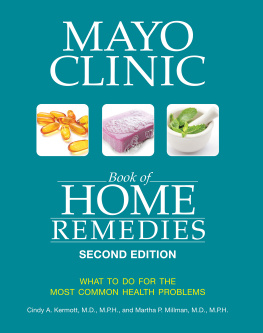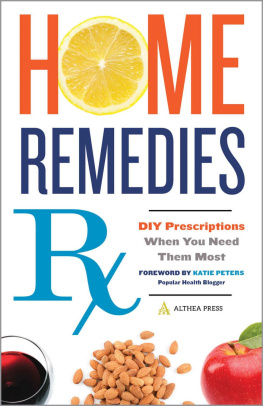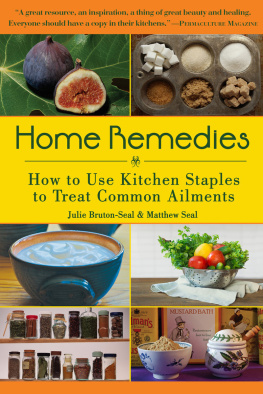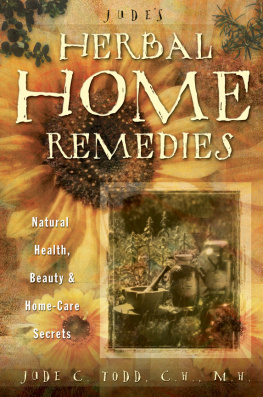Contents
Guide
Note to Readers
The information in this book should not be substituted for, or used to alter, any medical treatment or therapy without your doctors advice.
Contributors
Bookside Press
Editors Edward B. Claflin, E. A. Tremblay
Writers Matthew Hoffman, Eric Metcalf
Researchers Janel Bogert, Elizabeth Shimer
Project Editor Marianne Wait
Copy Editor Jeanette Gingold
Indexer Ellen Brennan
Illustrators Harry Bates, Inkgraved Illustration; Cindy Jeftovic
Designer Richard Kershner
Medical Advisors
Carolyn Dean, M.D., N.D. Consultant, Integrative Medicine, City Island, New York
Mitchell A. Fleisher, M.D. Clinical Instructor, University of Virginia Health Sciences Center and the Medical College of Virginia; Family Physician, Private Practice, Nellysford, Virginia
Larrian Gillespie, M.D. Retired Assistant Clinical Professor of Urology and Urogynecology, Beverly Hills, California
Chris Kammer, D.D.S. Center for Cosmetic Dentistry, Madison, Wisconsin
Chris Meletis, N.D. Chief Medical Officer and Director of Education Affairs, Pearl Clinic Professor of Natural Pharmacology, National College of Naturopathic Medicine, Portland, Oregon
Lylas G. Mogk, M.D. Henry Ford Visual Rehabilitation & Research Center, Grosse Pointe and Livonia, Michigan
Zorba Paster, M.D. Professor of Family Medicine, Dean Medical Center, University of Wisconsin-Madison
Ricki Pollycove, M.D., M.H.S. Clinical Faculty, University of California School of Medicine; Private Practice of Gynecology, San Francisco, California
David B. Posner, M.D. Chief of Gastroenterology,
Mercy Medical Center, Baltimore, Maryland; Assistant Professor of Medicine, University of Maryland School of Medicine
Adrienne Rencic, M.D., Ph.D. Attending Dermatologist, Mercy Medical Center, Baltimore, Maryland; Clinical Instructor, University of Maryland Medical System
Kevin R. Stone, M.D. Orthopedic Surgeon and Founder and Chairman of The Stone Foundation for Sports Medicine and Arthritis Research and the Stone Clinic, San Francisco, California
Cathryn Tobin, M.D. Pediatrician, Private Practice, Markham, Ontario
Using Home Remedies
A t the age of 85, Adelia Liercke of Clarence, Iowa, still takes the same cough medicine that her mother and father useda mixture of honey, onion, and lemon juice. When Betty W. Bishop of Hampton, Florida, gets a boil, she spreads the membrane of a boiled egg across it to draw out the corea trick that her mom taught her. When Cindy Leaf of Glenfield, New York, detects the beginning of a cold, she mixes up a potent medicine brew using a family recipe for natures penicillin that includes 24 fresh cloves of garlic.
Nearly every family has some home remedies that have been passed along from one generation to the next. Their origins are lost in the mists of time. Who was the first grandmother to serve peppermint tea to a sick grandchild? Why did a woodsman decide to crush the leaves of a jewelweed plant and spread it on poison ivy? Who was the first cook to discover that chicken soup can help you recover from the common cold?
Considering how often favorite home remedies have been used to cure everyday ailments and relieve pain, its a pity we dont know the names of the originators. They deserve Nobel Prizes in Practical Medicine. But maybe theres a better way to honor their contributions. We can use the home remedies that they so generously passed along to us.
More Than One Thousand RemediesRight Here!
Home remedies begin at homeand often thats where the secrets remain.
But with this book, youre opening the doors to thousands of homes, discovering the cornucopia of remedies that have been passed along for hundreds of years.
Some of the remedies came to us by mail from local readers. But that was only the beginning. We also uncovered folk cures used by early American pioneers, acupressure treatments of Chinese doctors, and the healing methods of tribal shamans. We discovered the leading home remedies endorsed by naturopathic doctors and massage therapists, herbalists and homeopathic physicians, specialists in cardiovascular medicine and favorite family doctors. Our search for these remedies carried us through history, from the era of Hippocrates to the battle-fields of World War I and the backyard gardens of twenty-first century herbal healers.
Selecting the Best
Though we cast a wide net, our final selection of the best home remedies was a selective process. To be honest, a number of tra-ditional home remedies didnt make the cut because they were just toowellstrange. The asafetida bag, once a cherished cure for colds, has a smell so noxious that its remembered with horror by those who used it. Other old remedies are so odd and complex that they arent worth passing on, except for curiositys sake. An Appalachian cure for warts, for instance, was to rub a potato on the wart, place the potato in a sack, and leave the sack at a fork in the road.
Of course, any remedy that does no harm might also do some good, especially when administered by someone who has a gentle, healing touch and cares deeply for the patient. But when we cast out the oddest, least-credible, most-complicated, and slightly risky, we were left with the wonderful (and sometimes wondrous) remedies that youll find in this book. Each of these remedies was then carefully reviewed by our board of advisorsincluding physicians, highly qualified specialists, and naturopathic doctorsto ensure that they are safe for you to use as recommended.
Every remedy in this book was carefully reviewed by our board of advisors to ensure that they are safe for you to use as recommended.
All Within Reach
As you read about the home remedies in this bookand start to use them yourselfyoull probably begin to recall tried-and-true healing techniques that come from your own family. But weve all gotten so used to blood tests, X rays, high-potency (and high-cost) prescription drugs, and all the other trappings of modern medicine that we tend to forget, or neglect, our amazing legacy of at-home cures. Time-tested remedies are just as useful today as they ever were. The tricks you learned from your parents and grandparents, like sprinkling meat tenderizer on a bee sting or putting a soothing tea bag on tired eyes, arent replacements for high-tech treatments, of course. But you can count on them to feel better fastand, in many cases, to prevent small problems from turning into bigger ones.
Theres something almost magical about watching a burn heal when you follow your grandmothers advice and apply a dab of aloe vera gel.
Theres something very satisfying about watching a burn heal almost like magic when you follow your grandmothers advice and apply a dab of aloe vera gel. Or when you inhale the scent of lavender and feel anxiety slip away. But nostalgia isnt the reason doctors continue to recommend home treatments. They recommend them because they work.
All those drugs in your medicine cabinet? At least 25 percent of them contain active ingredients that are similar or identical to those found in plants. The active substance in aspirinone of the worlds most popular medicationswas originally derived from white willow bark. The decongestant ephedrine is based on chemicals in the ephedra plant. The heart drug digitalis is derived from the foxglove. The cancer drug taxol comes from the Pacific yew tree. In fact, big drug makers continually send teams of scientists to remote locations to scour the countryside for medically promising chemicals.







